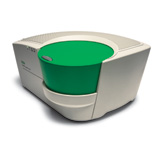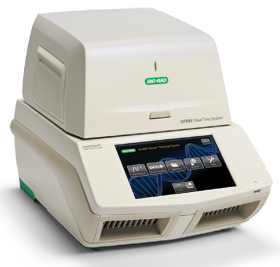|
RESOURCES AND INSTRUMENTATION >
INSTRUMENTATION

Thermal Cycling
The Bauer Core has a number of thermal cyclers for performing
standard PCR and Quantitative Real-Time PCR. For
more information about designing a real-time PCR experiment, please see Real
Time PCR
Techniques & Protocols.
 |
BioRad QX200
This system enables accurate quantification of rare targets through droplet digital PCR. The droplet generator takes 8 PCR reactions and encapsulates them into up to 20,000 droplets each. These droplet samples are then transfered to 96-well plates and the fluorecense for each droplet is detected on the droplet reader. The reader can detect samples labeled by EvaGreen or Taq-Man style probes FAM or HEX/VIC.
For more information on this instrument, see http://www.bio-rad.com.
To learn about using this instrument, please
contact Christian Daly cdaly@cgr.harvard.edu,
617-496-7105). |
 |
BioRad CFX96 Touch
This system is used for real-time
quantitative PCR in 96-well plates. Features include rapid cycling, a gradient capability
for protocol optimization, and a linear dynamic range of ten
orders of magnitude. The system is capable of
five-color detection with the following excitation/detection wavelengths:
- 450-490nm/510-530nm (FAM, SYBR)
- 515-535nm/560-580nm (HEX)
- 560-590nm/610-650nm (Texas Red)
- 620-650nm/675-690nm (Cy5)
- 672-684nm/705-730nm (Quasar 705)
For more information on this instrument, see http://www.bio-rad.com.
To learn about using this instrument, please
contact Christian Daly cdaly@cgr.harvard.edu,
617-496-7105). |
 |
BioRad CFX384 Touch
This system is used for real-time
quantitative PCR in 384-well plates. Features include rapid cycling, a gradient capability
for protocol optimization, and a linear dynamic range of ten
orders of magnitude. The system is capable of
four-color detection with the following excitation/detection wavelengths:
- 450-490nm/510-530nm (FAM, SYBR)
- 515-535nm/560-580nm (HEX)
- 560-590nm/610-650nm (Texas Red)
- 620-650nm/675-690nm (Cy5)
For more information on this instrument, see http://www.bio-rad.com.
To learn about using this instrument, please
contact Christian Daly cdaly@cgr.harvard.edu,
617-496-7105). |
 |
Stratagene MX3000p
This system is used for real-time
quantitative PCR in 96-well plates. It has a linear dynamic
range of seven orders of magnitude and is capable of four-color
detection:
- FAM/SYBR Green I (492nm-516nm)
- HEX/JOE/VIC (535nm-555nm)
- ROX/Texas Red (585nm-610nm)
- Cy5 (635nm-665nm).
For more information on this instrument, see http://www.mx3000p.com.
To learn about using this instrument, please contact
Christian Daly cdaly@cgr.harvard.edu,
617-496-7105).
MX
3000p Protocol (MS Word) |
 |
Applied Biosystems 7900HT
This system is used for real-time quantitative PCR in 96-well plates and TaqMan Low Density Array cards. Features include a fast cycling mode and a linear dynamic range of nine orders of magnitude. The system is capable of detecting the following probes:
SYBRGreen I, FAM, VIC, JOE, NED, ROX, TAMRA, and TET
For more information
on this instrument, see http://www.appliedbiosystems.com.
To learn about using this instrument, please contact
Jennifer Couget (jcouget@cgr.harvard.edu,
617-495-9402).
|
 |
MJ Opticon 2
This system can perform real-time
quantitative PCR in 96-well plates. Features include a gradient capability
for protocol optimization and a linear dynamic range of eight
orders of magnitude. The system is capable of
two-color detection:
- 523-543nm (FAM, SYBR)
- 540-700nm (HEX, TET, TAMRA, VIC)
Since this system is no longer supported by the vendor, we do not offer new training sessions for this instrument. Existing users may continue to use the instrument and should direct any questions to Christian Daly cdaly@cgr.harvard.edu,
617-496-7105.
Opticon
2 Protocol (MS Word) |
 |
MJ Tetrads(4)
These thermal cyclers can be used for high-throughput PCR and cycle sequencing applications. Each instrument has a capacity of four 96-well or 384-well PCR plates.
For more information on this instrument, see http://www.bio-rad.com.
To learn about using this instrument, please contact Claire Reardon (claire@cgr.harvard.edu, 617-384-7913).
Tetrad Protocol (MS Word) |
|